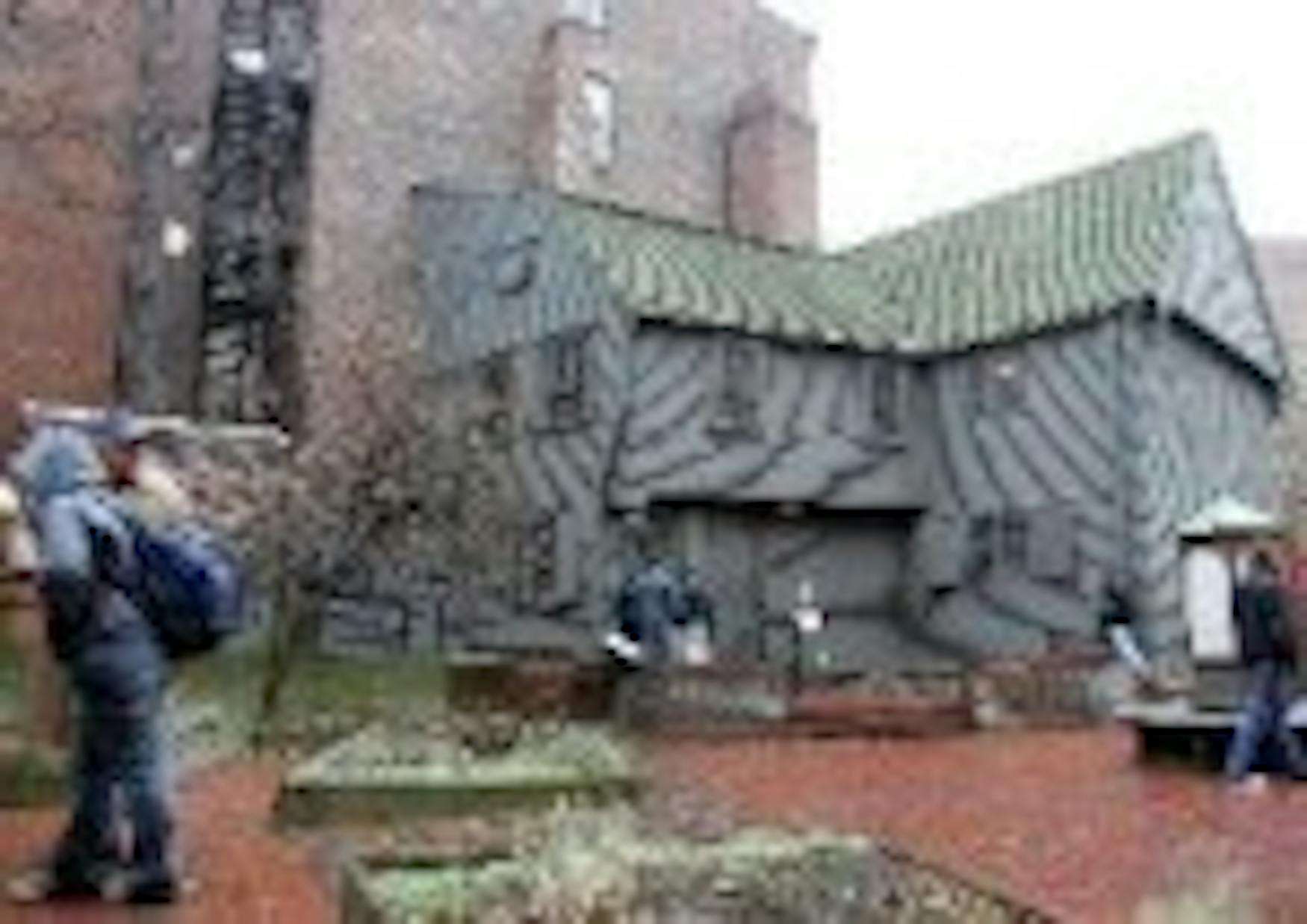The road not taken
Katie Hargrave M.A. '09 explored the hidden history of the Boston Freedom Trail
Just over a year ago, Katie Hargrave M.A. '09 embarked on her first tour of Boston's legendary Freedom Trail, the red brick path linking 16 of the city's historical sites. As she neared the end of the 2.5-mile trail it began to rain, leading her to stray from her tour group in an attempt to find a shortcut back.Anxiously making her way down different paths in search of an alternate route, Hargrave recalls stumbling unexpectedly onto an abandoned section of the trail.
Hargrave's accidental discovery prompted her to consider not only the specific consequences of abandoning a part of the Freedom Trail, but also the more general question of what it means to rewrite history.
"Freedom by the Bay: The Boston Freedom Trail," the art exhibit Hargrave displayed in September, is the product of a yearlong investigation of the trail's history. Her research focused specifically on how the trail was constructed and deconstructed, as well as tourists' conceptions of the trail.
The exhibit was put together under the guidance of Prof. Mark Auslander (ANTH), director of Brandeis' interdisciplinary Master's program in Cultural Production. Visitors participated in a self-guided tour of the Freedom Trail that consisted of a series of photographs and a video podcast .
Warm, vibrant and filled with contagious enthusiasm for the history of the Freedom Trail, Hargrave described her continued passion for learning about the trail's history.
"After walking the 2.5-mile trail a few times, it's pretty much forced itself upon me," she says. "I can't stop walking the damn thing, looking at maps of it and reading about it."
Auslander described Hargrave's innovative approach to historical research.
"Before Katie began this project, it simply hadn't occurred to me that the trail had changed over time and was in some sense a political instrument," he wrote in an e-mail to the Justice.
Curious about the origins of the Freedom Trail and the history of its reconstruction, Hargrave began her research in the Boston Public Library, where she was able to view maps of the old trail and track the changes made to the trail.
"I always start at the library and then meander as the archival materials take me," she explains.
By examining some of the old maps of the Freedom Trail, Hargrave learned that certain elements of the trail had been removed or reconstructed over time. Specifically, Scollay Square, a bustling commercial center in the 19th century, had been removed from the trail. Hargrave later found out that the Square was removed after its conversion into a governmental center in the late 1950s, she wrote in an e-mail to the Justice.
In addition, North Street, located in Boston's North End, was removed from the trail due to the Big Dig, the Central Artery/Tunnel Project that began at the end of the 20th century to reconstruct Boston's transportation system.
The trail now encompasses Hanover Street, which runs through Greenway Park, Hargrave wrote in an e-mail to the Justice.
Hargrave explained that part of the reason why people are so unaware of the changes to the trail is because the Boston government doesn't want the information being publicized.
"Tourism, really, is Boston's meat and potatoes and so the city guards its history closely," Hargrave says. "They have a hard time owning up to that fact."
In particular, the Boston government is reluctant to dispel myths about the Freedom Trail for fear of inhibiting tourism.
"Tourists like to believe that they are following in the historic steps of Paul Revere," Hargrave explains. "If they were to find out this weren't the case, the city fears it would impact tourism."
Hargrave says the majority of today's tourists are attracted by the idea of re-experiencing historic events.
"When I hear people talk about the Freedom Trail, they say that this is the path that historical figures walked," she says. "The language they use is one of permanence."
Auslander also attributes a general lack of knowledge about the trail's history to the fact that people simply don't take the time to pause and question the trail's origins.
"Many of us haven't stopped to think: What does this long, meandering line really mean?" Auslander said.
After her initial discovery, Hargrave rewalked the trail with different groups of tourists, during which she observed a "zombie syndrome" among the masses that walked beside her.
"It was very interesting to watch people as they walked the trail," Hargrave says. "They just walked the line and didn't pay attention to what was around them."
Auslander explained that, although the Freedom Trail is endlessly photographed by tourists, the majority of people ignore the trail's "curious histories" and "how the [trail's] evolution illuminates our changing understandings of history and the city."
Hargrave's goal is to open people's eyes to the construction of the Freedom Trail and history at large.
"I'm hoping that people will become aware and more critical of the built environment of our cities as it is meticulously created through tourist sites," Hargrave says.
By not simply walking the well-trodden trail with her eyes pressed to the ground but engaging with and questioning what she was seeing, Hargrave was able to bring to light a new way of perceiving the Freedom Trail.
Hargrave's work "forces us to see the present city in a new way, by forcing us to see Boston's history in a new way," Auslander said.
Hargrave plans to earn her Master's in Fine Arts and teach art at the university level so that she can continue to motivate people to think and question history through the use of art.
"It's important to question how history is constructed," she says. "Because it is constructed.



Please note All comments are eligible for publication in The Justice.